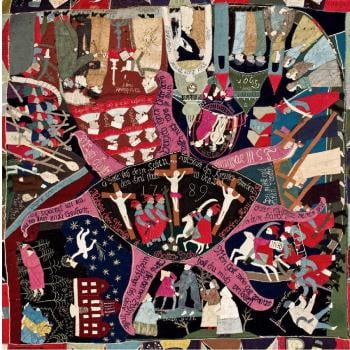Therefore God exalted him to the highest place and gave him the name that is above every name, that at the name of Jesus every knee should bow, in heaven and on earth and under the earth, and every tongue acknowledge that Jesus Christ is Lord, to the glory of God the Father. ~ Philippians 2:9-11
 "It's not enough just to interpret for deaf children. If the child doesn't know the signs, they won't understand. Much of our work is about language development, building communication skills. I use pictures, charts, stories, and pantomime."
"It's not enough just to interpret for deaf children. If the child doesn't know the signs, they won't understand. Much of our work is about language development, building communication skills. I use pictures, charts, stories, and pantomime."
Dominican Sister, Joan Mary Finn is an inventive and enthusiastic educator who coordinated the diocesan Deaf Ministry on Long Island until it was closed down a few years ago. She still volunteers with the Deaf, whom she calls her "family." She has worked with them for forty years, but she first spent eleven years teaching in parochial schools.
"It was the best preparation for working with the Deaf, because I demanded a lot from my hearing students, and I was used to having high standards. A deaf child can do so much if you expect it of him. But some of the teachers who had only worked with the Deaf made allowances for them; they'd let them off the hook and some children developed behavioral problems. I've always expected them to be responsible, to remember to bring in their books and do their work properly. It's my job to get them ready for adult responsibilities.
"I'm always building vocabulary," she says, defining the core of her work. "For instance, when I teach them to read: If I was going to introduce the word 'cat' I might bring in a cat or a kitten and have them touch it, feel its fur, look at its whiskers, its tail, watch it move. I'd point out that a cat can play and run, and since they'd already experienced it, I could bring in new vocabulary based on the experience."
Asked to boil her life's work down to a few helpful bullet points, Sister replies humbly, "I haven't always known what to do. It's a lot of trial and error figuring out what works and what doesn't." But she goes on to explain that it's important to start simple and build from there—what she and others in education call going "from the known to the related unknown."
Sister Joan Mary's tips on building language for the Deaf:
- Begin with a simplified idea and find ways to link to the more complex one. When Sister Joan Mary taught her students about the Good Samaritan she began with the idea of a "good helper," and made sure they understood that term first. Next, she used her favorite Catholic picture books and shared the actual Bible story. After telling it to them as simply and vividly as possible, she would point to the pictures of the different characters and quiz them. "Was the first one who passed the hurt man a 'good helper'? They would all say, 'No!' Was the second one? 'No!' And when they chose the last one I would put a star next to the 'good helper.' My goal is to get them to answer the question, 'How can you be a good helper?'"
"Preparing deaf children to understand the Mass, I ask them, 'Who are your friends? Let's pray for them!' I talk about the apostles as Jesus' 'Special 12' friends, and talk about the 'special meal' that Jesus had with them. Eventually, when they understand that Jesus had twelve friends, I can introduce the sign for 'apostles' and increase their vocabulary." - Be as visual as possible. Sister Joan Mary uses beautifully illustrated children's Bibles for kids of all ages, including resources from other Christian denominations, because she's mostly just using the pictures. "I want them to understand that what I'm teaching is in the Bible," she says. "Jesus told us these stories." She emphasizes Jesus' love for them, and often refers to works of art depicting Jesus with children.
- The interactions between teacher and student are very important. The children who pay attention often ask great questions. "I had a very bright child in my class. After the Creation Story (in which he had heard that after making the people God said 'That was good!') he asked, 'Why are there bad people?' I thought, if he can ask the question, he can receive the answer. I explained that we can be good and know right from wrong, but some people pick the wrong thing to do. They become bad by picking the wrong things."
Sometimes this sort of spontaneous discussion is the perfect segue into a more complex idea, like sin. Sister Joan Mary creatively strings them together in ways that help kids make important connections. - Use music! "I use music in the sense that I use the rhythms of it. I sing the song 'Frère Jacques' and I use the words 'I am sorry, I am sorry . . .' The repetitions are helpful."
- Make it physical as well as visual. "To help them understand penance, we make up stories and act them out so that one person confesses and the other person has to forgive. There is a sign 'for' and a sign 'give,' but put together as the word 'forgive,' it has a new meaning. For instance, I'll deliberately knock a book off the desk and then sign, 'I'm sorry. Please forgive me,' and get them to sign back, 'I forgive you.' I do a number of these demonstrations and then transition to the idea of telling God they're sorry and asking for God's forgiveness until they develop the concepts needed for First Penance."
Forgiveness and healing are closely linked in the Bible. "When we do the story of the ten lepers I bring in a roll of gauze and I designate a few lepers from among the children. We wrap gauze bandages around their hands so that they look the part. And one child wears a sign that says 'Jesus' on his chest. I tell the lepers 'You have to stay away from others! You're sick!' And I have them plead for healing. 'Please! Please help me!' And then Jesus says, 'Yes, I love you and I will help you!' Then he takes the gauze off. One leper returns to say 'Thank you' to Jesus. We remember to say 'Thank you' to Jesus everyday. At the end of class our prayer includes things for which we are thankful."





